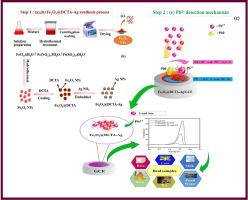一种用于铅检测的新型Fe2O3@DCTA-Ag纳米复合传感器:Box-Behnken设计优化和实际应用
IF 4.9
2区 化学
Q1 CHEMISTRY, ANALYTICAL
引用次数: 0
摘要
铅(Pb2+)污染对人类健康和环境安全构成严重威胁,强调需要灵敏和选择性的检测方法。在这项研究中,我们开发了一种新的纳米复合材料,即4-(3,5-二甲基- 1h -吡唑-1-基)羧酸盐(DCTA)功能化的Fe₂O₃纳米颗粒,并以银纳米颗粒(Fe2O3@DCTA-Ag)装饰。利用该材料制备了基于差分脉冲伏安法(DPV)的Pb2+电化学传感器。采用响应面法(RSM)结合Box-Behnken设计(BBD)对传感器性能进行优化,通过34因子设计评估pH、接触时间、液滴体积和干燥时间的影响。一个多变量回归模型将峰值电流与这些因素联系起来,确定最佳条件。在此条件下,传感器的线性检测范围为0.2 nM ~ 10 μM,检测限为0.2 nM。在大米、玉米、牛奶、蜂蜜、茶叶等多种食品样品和环境水样中均表现出良好的选择性和稳定的性能,具有一定的实用性。本文章由计算机程序翻译,如有差异,请以英文原文为准。

A novel Fe2O3@DCTA-Ag nanocomposite sensor for lead detection: Box-Behnken design optimization and real-world applications
Lead (Pb2+) contamination poses serious risks to human health and environmental safety, highlighting the need for sensitive and selective detection methods. In this study, we developed a novel nanocomposite, Fe₂O₃ nanoparticles functionalized with 4-(3,5-dimethyl-1H-pyrazol-1-yl)carboxylate (DCTA) and decorated with silver nanoparticles (Fe2O3@DCTA-Ag), using simple and efficient synthesis techniques. This material was employed to fabricate an electrochemical Pb2+ sensor based on differential pulse voltammetry (DPV). The sensor performance was optimized using a response surface methodology (RSM) combined with a Box-Behnken design (BBD), evaluating the effects of pH, contact time, drop volume, and drying time through a 34 factorial design. A multivariate regression model correlated the peak current with these factors, identifying the optimal conditions. Under these conditions, the sensor exhibited a linear detection range of 0.2 nM to 10 μM, with a detection limit of 0.2 nM. It showed excellent selectivity against co-existing ions and consistent performance in various food samples (rice, corn, milk, honey, tea) and environmental water samples, demonstrating its practical applicability.
求助全文
通过发布文献求助,成功后即可免费获取论文全文。
去求助
来源期刊

Microchemical Journal
化学-分析化学
CiteScore
8.70
自引率
8.30%
发文量
1131
审稿时长
1.9 months
期刊介绍:
The Microchemical Journal is a peer reviewed journal devoted to all aspects and phases of analytical chemistry and chemical analysis. The Microchemical Journal publishes articles which are at the forefront of modern analytical chemistry and cover innovations in the techniques to the finest possible limits. This includes fundamental aspects, instrumentation, new developments, innovative and novel methods and applications including environmental and clinical field.
Traditional classical analytical methods such as spectrophotometry and titrimetry as well as established instrumentation methods such as flame and graphite furnace atomic absorption spectrometry, gas chromatography, and modified glassy or carbon electrode electrochemical methods will be considered, provided they show significant improvements and novelty compared to the established methods.
 求助内容:
求助内容: 应助结果提醒方式:
应助结果提醒方式:


